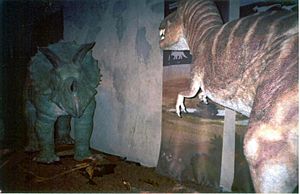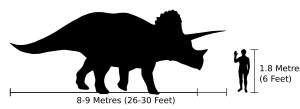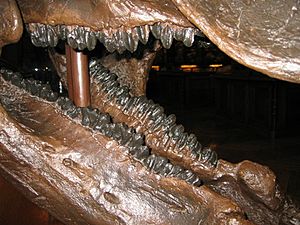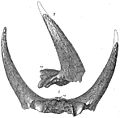Triceratops facts for kids
Quick facts for kids TriceratopsTemporal range: Late Cretaceous (about 68 to 66 million years ago)
|
|
|---|---|
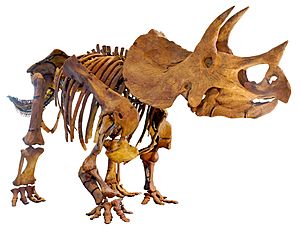 |
|
| A skeleton of T. prorsus at the Natural History Museum of Los Angeles | |
| Scientific classification |
|
| Kingdom: | Animalia |
| Phylum: | Chordata |
| Clade: | Dinosauria |
| Order: | †Ornithischia |
| Family: | †Ceratopsidae |
| Subfamily: | †Chasmosaurinae |
| Tribe: | †Triceratopsini |
| Genus: | †Triceratops Marsh, 1889 |
| Type species | |
| †Triceratops horridus Marsh, 1889
|
|
| Species | |
|
|
| Synonyms | |
|
Other names sometimes linked to Triceratops
Agathaumas? Cope, 1872
Polyonax? Cope, 1874 Bison alticornis Marsh, 1887 Sterrholophus Marsh, 1891 Claorhynchus? Cope, 1892 Ugrosaurus Cobabe & Fastovsky, 1987 Nedoceratops? Ukrainsky, 2007 Ojoceratops? Sullivan & Lucas, 2010 Eotriceratops? Wu et al., 2007 Tatankaceratops? Ott & Larson, 2010 |
|
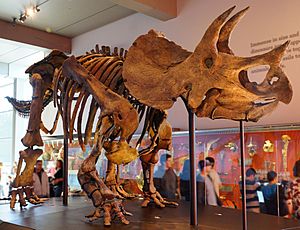
Triceratops was a giant plant-eating dinosaur from the late Cretaceous period. Its name means "three-horned face," which perfectly describes its most famous feature. These amazing dinosaurs lived mainly in North America. Adult Triceratops could grow up to 9 meters (30 feet) long and 3 meters (9 feet) tall. They likely weighed around 5,400 kilograms (12,000 pounds), which is about the same as a large truck!
Triceratops was a low browser, meaning it ate plants close to the ground. It had a strong, bony beak at the front of its jaws, perfect for grasping plants. Its jaws also had many grinding teeth packed closely together. Triceratops needed strong defenses to protect itself from large meat-eating dinosaurs like theropods. It had a huge bony shield, called a frill, that covered its neck. Scientists have even found tooth marks from predators on these frills and on the bones near their hips.
Many Triceratops fossils have been found since the dinosaur was first described in 1889. It's one of the most common dinosaurs found in certain areas. One paleontologist said it's hard to walk in the Hell Creek Formation without finding a Triceratops fossil. Over 47 complete or partial skulls were found in just one area between 2000 and 2010. Scientists have even discovered fossils showing Triceratops at different life stages, from tiny hatchlings to full-grown adults.
Contents
What did Triceratops look like?
How big was Triceratops?
Individual Triceratops were usually about 7.9 to 9.0 meters (26.0–29.5 feet) long. They stood about 2.9 to 3.0 meters (9.5–9.8 feet) tall. Their weight could range from 6.1 to 12.0 tonnes (13,000–26,000 pounds). That's like a small bus!
The amazing Triceratops skull
The most striking part of Triceratops was its huge skull. It was one of the largest skulls of any land animal ever! The biggest skull found was about 2.5 meters (8.2 feet) long. This means its skull could be almost one-third the length of its entire body.
The skull had three horns: one short horn above its nose and two long horns, each about 1 meter (3 feet) long, above its eyes. Unlike most other horned dinosaurs, Triceratops' frill (the bony shield behind its head) was mostly solid. Other horned dinosaurs often had large holes in their frills.
Triceratops legs and how it walked
Triceratops had strong, sturdy legs. Its front feet had three hooves, and its back feet had four hooves.
For a long time, scientists debated how Triceratops stood and walked. Some thought its front legs sprawled out to the sides, like a lizard, to support its heavy head. You can see this in old dinosaur paintings. However, evidence from fossil footprints and skeleton reconstructions shows that Triceratops walked more upright. Its elbows were bent and slightly bowed out, similar to how a modern rhinoceros stands.
How Triceratops lived
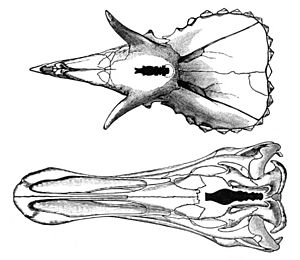
Even though Triceratops are often shown living in big groups, there isn't much fossil evidence to prove they lived in herds. Most finds are of single individuals.
However, in 2012, a group of three Triceratops fossils were found together in Wyoming. This group included an adult, a sub-adult, and a juvenile. Scientists are still studying these remains, but it suggests they might have traveled as a family. The bones also showed signs that a Tyrannosaurus might have attacked or eaten them, especially the largest one. There were broken bones and puncture marks from Tyrannosaurus teeth on the front limbs.
Triceratops fossils are very common. One paleontologist reported seeing 200 specimens of T. prorsus in the Hell Creek Formation in Montana. Another claimed to have seen over 500 skulls! Teeth, horn pieces, and frill fragments are found everywhere in the latest Upper Cretaceous rocks of western North America. Triceratops was the most common plant-eating dinosaur of its time. Some scientists believe it made up about 5/6ths of all large dinosaurs at the end of the Cretaceous period.
Triceratops was one of the last horned dinosaurs to live before the Cretaceous–Paleogene extinction event. This was the event that wiped out most dinosaurs. Other related dinosaurs like Torosaurus and Leptoceratops also lived at this time, but their fossils are much rarer.
What did Triceratops eat?
Triceratops were plant-eaters. Because their heads were low to the ground, they probably ate low-growing plants. However, they might have used their horns, beak, and strong bodies to knock down taller plants like palms and cycads. Their jaws had a deep, narrow beak at the front, which was good for grabbing and pulling off plants.
Triceratops teeth were arranged in groups called "batteries." Each side of their jaws had 36 to 40 columns of teeth. Each column had 3 to 5 teeth stacked on top of each other. This means a Triceratops could have anywhere from 432 to 800 teeth in total! Only some of these teeth were used at any one time, as new teeth were always growing to replace old ones. The large size and many teeth of Triceratops suggest they ate huge amounts of tough, fibrous plants.
What were the horns and frill for?
Scientists have wondered a lot about why Triceratops had such big horns and frills. The two main ideas are that they used them for fighting or for showing off to other Triceratops. Most scientists now think showing off was the main reason.
For a long time, people thought Triceratops used its horns and frill to fight predators like Tyrannosaurus. This idea was first discussed in 1917. There is some evidence that Tyrannosaurus did attack Triceratops head-on. Scientists found partially healed Tyrannosaurus tooth marks on a Triceratops brow horn and cheekbone. The bitten horn was also broken, but new bone had grown, meaning the Triceratops survived the attack! We also know Tyrannosaurus ate Triceratops, as heavily scarred Triceratops hip and tail bones have been found.
People also often imagine Triceratops fighting each other by locking horns. Studies show this kind of fighting would have been possible, but it might not have been exactly like how modern horned animals fight. Scientists still disagree on how often this happened.
The large frill might also have helped Triceratops control its body temperature. This is similar to a theory about the plates on Stegosaurus. However, this idea alone doesn't explain why different horned dinosaurs had such unique and fancy frills. This suggests that the frill's main purpose was for display.
The idea that horns and frills were for showing off, perhaps during courtship, was first suggested in 1961. This idea is now widely accepted. The fact that each horned dinosaur species had very different horns and frills suggests they were important for visual display. This could be for attracting mates or for other social communication. Modern animals with horns and fancy displays use them in similar ways. A 2006 study of the smallest Triceratops skull showed that the frill and horns grew very early in life, even before the dinosaur was old enough to mate. This means they were probably important for general communication and for recognizing other Triceratops of the same species.
What injuries did Triceratops have?
One Triceratops skull had a hole in its cheekbone. It looked like a puncture wound that happened while the dinosaur was still alive. This is because there were signs of healing around the wound. When scientists looked closely, the hole was about the same size as the tip of a Triceratops horn. This suggests that Triceratops might have fought with each other.
Images for kids
-
1896 skeleton drawing of T. prorsus by O. C. Marsh
-
T. prorsus at the Carnegie Museum of Natural History
-
Skull of Triceratops horridus from the Houston Museum of Natural Science
-
Close-up of a Triceratops pelvis at the Oxford University Museum of Natural History
-
The first mounted T. horridus skeleton, nicknamed "Hatcher", at the Smithsonian Museum
-
A Triceratops mounted next to a Tyrannosaurus at the Los Angeles Natural History Museum
-
Front view of a skull with a clear bony fringe, Houston Museum of Natural Science
-
Animals of the Hell Creek Formation, about 66 million years ago (Triceratops shown in sepia skin)
-
1901 drawing by Charles R. Knight
See also
 In Spanish: Triceratops para niños
In Spanish: Triceratops para niños


